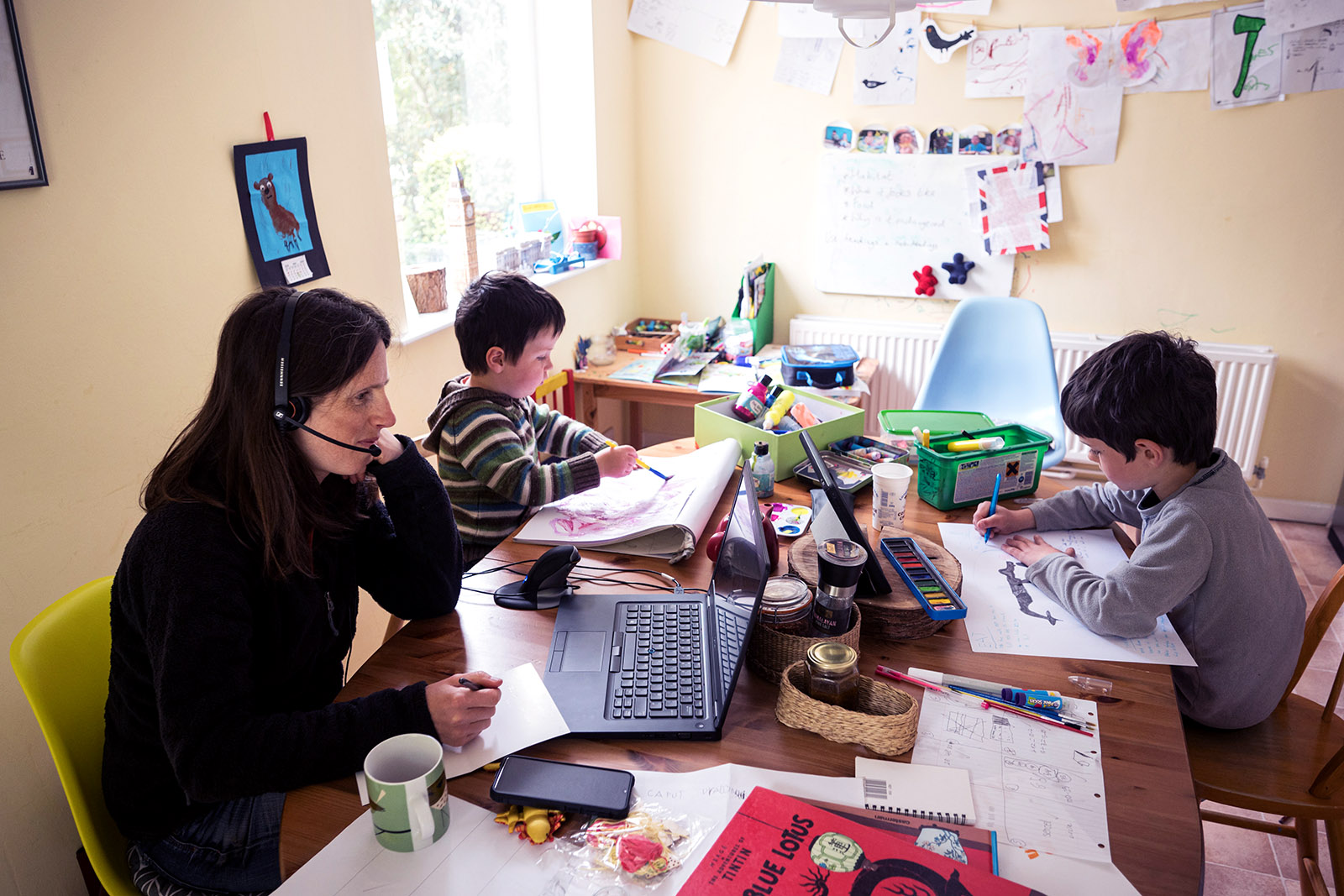Caregivers Need Support From Employers — Europe Is Setting the Example

Children complete homeschooling activities as their mother works in northern England during the pandemic. Parental leave was a highly topical discussion point regarding increasing parental leave and promoting a fair share of parental leave between parents.
Photo: Oli Scarff/AFP via Getty Images
Do you know how many caregivers are in your organization? Did you know that it could be as many as one in two people who have significant additional caregiving duties during the COVID-19 epidemic?
Mercer recently ran a series of focus groups to discuss how best to support caregivers in the workplace. We brought together a group of multinational companies to examine how workers coordinate care and support for their dependents ─ including children, parents, partners and other family members ─ whilst working and how employers can improve their employee experience. One in three of them identified as caregivers.
Why Is Addressing Caregiver Needs So Important?
Research shows that the pressure of being a caregiver can have a substantial negative impact on a person’s mental and physical health, as well as pay and promotion. Studies show that over half of workers globally coordinate the care and maintenance or provide for the health care of a dependent, the majority (two-thirds) of whom are women or older workers. Before the COVID-19 outbreak, women in the EU already spent 13 hours more than men every week on unpaid care and housework.
In the U.K. alone, 1.4 million people provide more than 50 hours of work toward unpaid care per week. The value of this unpaid labor is estimated to be at least 119 billion pounds ($164 billion) annually. Almost one-quarter of these carers (24%) have considered giving up their jobs completely because of the stress. Pre-COVID, estimated levels of working carers varied significantly around the world, but to get an idea of scale, a study in the U.S. found the number increased by 9.5 million from 2015 to 2020. Carers report being in worse health compared to five years ago, and financial wellness is a growing concern: 28% have stopped saving, 23% have taken on more debt and 22% have used up personal savings.
Emotional, physical and economic problems can escalate for caregivers. They can fall behind in pay and promotion because of the pressure of caring responsibilities and may not put themselves forward for bigger roles. Their own health has been shown to suffer as a result of this extra pressure. These compounding factors can lead to an overall decline in their lifetime wealth accumulation as well as burnout and stress. This has a knock-on effect into later life and pension accrual, too. Women in OECD countries, on average, experience a 26% gap in their pensions compared to men. Much of this gap develops between the ages of 25 and 44, typically during the child care period.
COVID-19 intensified these effects for many caregivers. In France, 36% of women experienced an increased workload (compared to 29% of men), while school closures resulted in 43% reporting an increase of four hours or more of additional household chores. In a U.K. study, 46% of caregivers reported working the same hours at their job, but that their work is negatively affected by tiredness, lateness and stress.
So, how do we combat this issue? Soon, there will be new legislation across Europe and EEA countries resulting from an EU directive setting out minimum standards, which must be put into national laws by August 2022. The objective of the directive is to provide better work-life balance for carers, through more equal sharing of parental leave, giving the right to request flexible working and providing a minimum amount of paid carers leave. This is good news for employers: Absence and stress as a result of juggling work and caring could be costing U.K. businesses over 3.5 billion pounds (nearly $5 billion) every year. This directive is a good starting point for a framework of support that will reap rewards for carers and society alike.
Do you know how many caregivers work in your organization, and how you can better support them? Asking yourself questions like these can help create a culture of caring and help employees thrive.
The Business Case for Supporting Caregivers
There is a strong business case for employers to support caregivers as the right support can:
- Positively impact recruitment and retention of carers
- Increase engagement and productivity
- Increase diversity in the workplace by enabling more carers (often women or older workers) to balance caring with work
- Lead to improved employee health and well-being
- Contribute to improved employee relations
- Enhance an employer’s corporate reputation by being viewed as more innovative, more socially conscious and more inclusive by the market
A modern work-life balance policy will contribute to improving employment rates and to reducing poverty and social exclusion, in line with EU priorities reflected in the Europe 2020 targets.
What Can Employers Do to Support Caregivers in the Workplace?
In our focus groups, we discussed the best options for employers to offer support and examined what employers are doing well and what is working. The approaches fell into three main categories:
- Inclusive policies. Employers can design policies and programs that recognize the caregiving role. Examples include supportive employee networks where people can find help and like-minded colleagues and communications from the employer that acknowledge and encourage people to identify that they have caregiving responsibilities so that managers understand and can help them when needed. Organizations are using Mercer’s ONDO platform successfully as a digital networking platform for carers.
- Flexibility and work. Employers are getting creative about flexible working. For example, giving employees more flexibility as to when and how their work gets done, combined with carer leave and time-off policies. There are extensive different ways to do this, from granting time to attend medical appointments with those they care for to offering fully flexible working and flexible retirement programs. Parental leave was also a highly topical discussion point with many of the focus group participants, who focused on increasing parental leave, equalizing it and promoting a fair share of parental leave between parents.
- Caregiving benefits. Caregiving benefits take many forms. Examples include access to support resources and subsidized care. Some creative employers have moved to providing subsidized child care and elder care, or at home nursing, and access to vendors who can assist with caregiving needs. Digital health care solutions and telemedicine are also highly valued benefits for caregivers who then do not have to worry about traveling to an appointment. Providing caregiver benefits will allow employers to attract/retain talent who previously had to choose between caregiving and working — especially women who are more likely to take on caretaking responsibilities.
Awareness Drives Change
When asked the question “do you know how many caregivers are in your organization?” these focus groups admitted that none of them knew the answer; 100% answered no but made a commitment to go back to their organizations to find out. Activity to assess and support caregivers in the workplace is likely to accelerate in terms of compliance with forthcoming local legislation enacted following the EU Directive.
Do you know how many caregivers work in your organization? And how you can better support them? These questions can lay the foundation of an organization’s strategy to create a culture of caring and help employees thrive.




